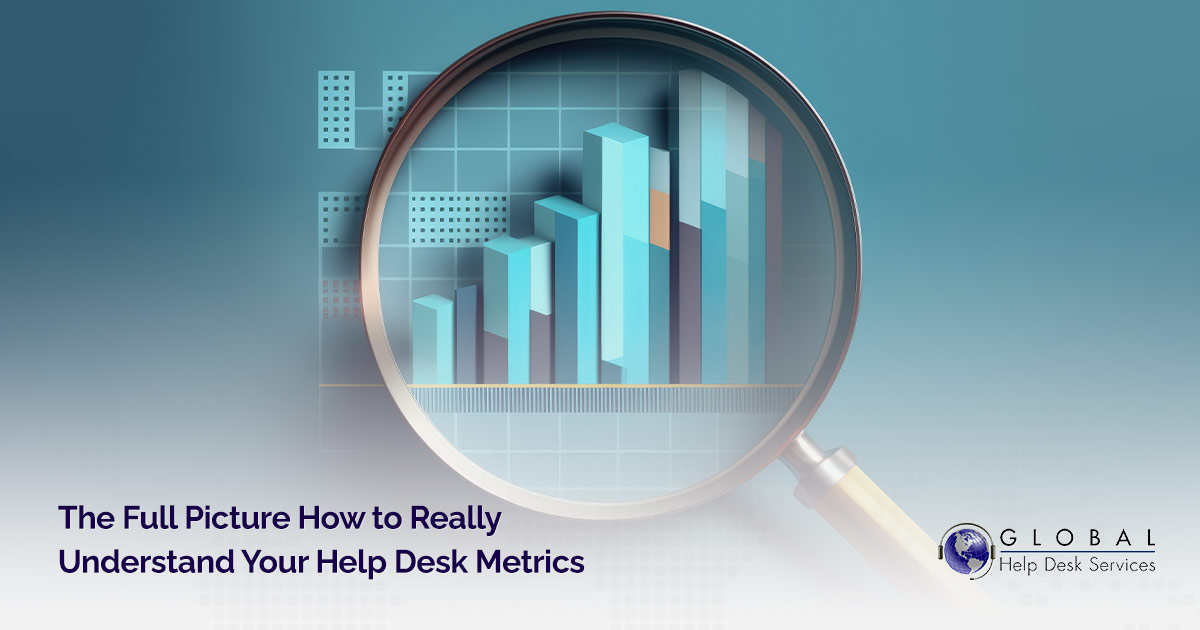You’ve heard the saying “what gets measured gets managed.” And you’re probably already putting it to use — tracking KPIs to measure and manage the most important aspects of your IT support operations.
But looking at certain help desk metrics like first-contact resolution rate and customer satisfaction (CSAT) score is like looking at a single puzzle piece. Say, for example, you’re reviewing the statistics for an employee with longer-than-average talk times. Is he chatting too long instead of getting to a solution quickly? Or is he finding and addressing additional issues the caller might have, leading to a higher CSAT score?
The talk times alone won’t tell you that. You need to look at complementary help desk metrics to see the bigger picture. It’s a little bit like your body: When there’s an issue with one system, others are also affected. So, while help desk metrics are important, no single metric is a stand-alone indicator of performance. Here are some help desk metrics to consider together to give you a truer understanding of what’s really going on at your help desk.
Talk Time and Resolution Rate
You want your help desk to solve problems. That’s kind of the whole point. And because you have an operating budget, you want your agents to quickly give correct answers and move on to the next caller’s issue.
Lots of help desks focus on talk time, which is the time it takes to close a ticket. But that number doesn’t tell you the whole story. You should also factor in the resolution rate, which is the number of calls your team actually finds a solution for. Closing tickets quickly without providing valuable answers won’t help your callers, and they’ll start looking elsewhere for help.
If both your talk time and resolution rate are high, this could be good news. Your agents may be using those extra minutes to provide meaningful answers, which will improve your other help desk KPIs, like satisfaction rate. Longer talk times may also save you money. If Tier 1 agents are spending a lot of time answering questions (and they have the resolution rates to prove it), they’re likely stopping issues from escalating up the chain to Tier 2 and Tier 3 agents, whose time is probably pricier than at Tier 1.
But a low resolution rate coupled with long talk times could mean your agents aren’t accurately leveraging your knowledge base to answer questions, or that tickets are landing in the wrong support tier and are being managed by agents who lack the expertise needed to solve those issues. If those agents aren’t appropriately escalating those tickets to agents with more experience, performance issues will arise.
To address this, try instituting knowledge base adherence benchmarks or making it easier for agents to pass issues up the chain of command to other support tiers. If your agents don’t know enough to answer the questions posed to them, they’ll waste time and frustrate customers.
Response Time and Resolution Rate
Another potentially misleading help desk metric is response time, which is the time between the initial request and the first time an agent reaches out to the customer. Customers want to know their requests aren’t falling into a black hole, never to be heard from again. They need to know someone who understands their question is working behind the scenes to fix it, even if it takes more time than they expected.
If you’re the person running the help desk, response time is typically directly tied to CSAT Scores. Customers who get an answer quickly can cross that problem off their to-do list and will be happier with your help desk.
But short response times aren’t the full story. If your agents are responding quickly but take too long to solve the original question, customers aren’t getting what they need from your help desk. It’s also important to set reasonable expectations for your customer. Definitely let customers know when someone from the help desk will contact them about their ticket – but don’t promise a specific timeframe in which the ticket will actually be resolved. There’s no way for you to predict the complexity of all incoming tickets, and setting a timeline that is too short will only frustrate your customers.
And remember: Long response times don’t necessarily indicate performance problems. For starters, consider what else your agents have on their plates. Are they handling tasks they shouldn’t be? Are they frequently struggling to find the right agent to answer a complex question? Are they getting the support they need from your second and third-tier agents? Looking at everything that happens during their shift could help you find a problem and design a solution that will help your agents focus on their clients and improve both their response times and resolution rates.
Number of Calls Per Agent and Follow-Up Requests
If agents are dealing with too many caller follow-up requests, they may not be taking as many original or new support calls per hour as you’d like. High follow-up requests can signify caller dissatisfaction with either your help desk or more likely Tier 2 or Tier 3 support’s lack of response to escalated tickets. If customers have to wait for an answer and feel compelled to call the help desk several times for an update, it’s safe to say they’re not having a good experience. Next time, they might try other avenues to get a solution.
As a manager, you can gauge this issue by looking at how much of your call volume is follow-up requests. If it’s 20 percent or more, this may indicate a problem. And if one agent has an unusually high volume of follow-up requests, he or she might need more training about how to handle calls or education about the specific issues they’re being asked to solve.
One way to decrease follow-up requests is to ask the customer what else you can help them with on every call. This will likely increase your talk time but, more importantly, it can also drive down follow-up requests and increase CSAT scores.
As you can see, no single help desk metric tells the complete story about your performance. You need to consider your metrics holistically to accurately gauge how well your agents are succeeding with the “help” part of the help desk.
Looking to dive deeper into your help desk performance? Read our ebook on Measuring Help Desk ROI or speak to one of our help desk experts today.

